
Tulbaghia is a genus of monocotyledonous herbaceous perennial bulbs native to Africa, belonging to the amaryllis family. It is one of only two known genera in the society garlic tribe within the onion subfamily. The genus was named for Ryk Tulbagh (1699–1771), one time governor of The Cape of Good Hope.

Kniphofia is a genus of perennial flowering plants in the family Asphodelaceae, first described as a genus in 1794. All species of Kniphofia are native to Africa. Common names include tritoma, red hot poker, torch lily and poker plant.

Manilkara is a genus of trees in the family Sapotaceae. They are widespread in tropical and semitropical locations, in Africa, Madagascar, Asia, Australia, and Latin America, as well as various islands in the Pacific and in the Caribbean. A close relative is the genus Pouteria.
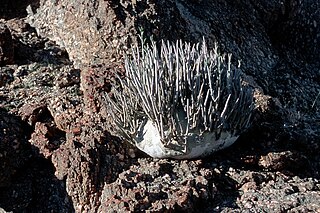
Adenia is a genus of flowering plants in the passionflower family Passifloraceae. It is distributed in the Old World tropics and subtropics. The centers of diversity are in Madagascar, eastern and western tropical Africa, and Southeast Asia. The genus name Adenia comes from "aden", reported as the Arabic name for the plant by Peter Forsskål, the author of the genus.
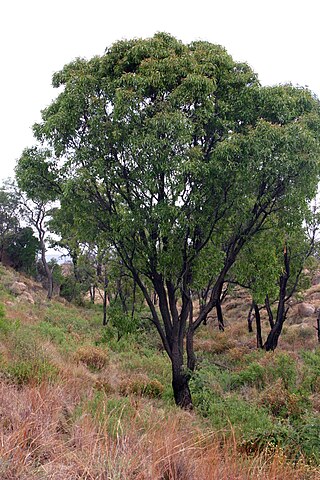
Faurea saligna is a graceful, semi-deciduous tree in the family Proteaceae. It grows to about 10 metres, or up to 20 metres under forest conditions. Found from tropical Africa south to the Transvaal, Swaziland and Natal, often in large communities on sandy soil and along stream beds.
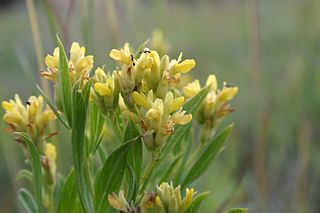
Pearsonia is a genus of 12 species of plants belonging to the family Fabaceae and occurring in Africa south of the equator with 1 species found on Madagascar. The species are usually herbs or shrublets with woody rootstocks. Leaves are usually sessile and 3-foliolate. The inflorescence is a congested or lax terminal raceme. The name of this genus commemorates the South African botanist Henry Harold Welch Pearson.
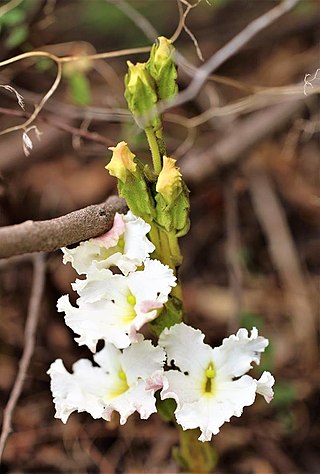
Harveya is a genus of parasitic plants in the family Orobanchaceae. The approximately 29 species included are native to Africa from Eritrea to South Africa, Madagascar and the Mascarene Islands, the Arabian Peninsula, and Turkmenistan in Central Asia. In South Africa they are commonly known as 'inkblom', because early settlers used the flowers to make ink, and this is the source of the English common-names for the genus of ink flower or ink plant.

Argyrolobium is a genus of flowering plants in the family Fabaceae. It belongs to the subfamily Faboideae. Members of this genus are found in Africa, western and south Asia, and southern Europe.
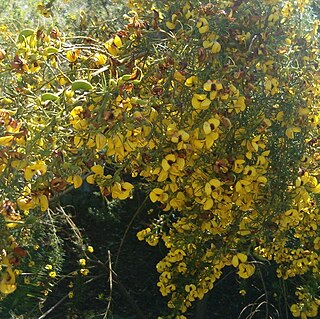
Cyclopia, the honeybush, or heuningbos in Afrikaans, is a genus of some 20 species of flowering plants in the legume family Fabaceae, subfamily Faboideae. Species of the genus are native to the southern and southwestern Cape Provinces of South Africa.

Cyphia is a genus of flowering plants in the bellflower family, native to Africa; and particularly South Africa. It has been placed in its own subfamily, Cyphioideae. It is closely related to the genus Lobelia.Cyphia comes in shades of white to mauve, whereas lobelias have strong colours of blue to purple. Species in this genus have a bilabiate corolla; with 3 lobes on top and 2 below.
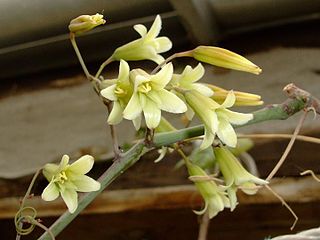
Adenia digitata is a species of flowering plant in the passionflower family, Passifloraceae. It is a climbing geophyte, from 0.2 to 3 meters long, which grows from a tuber. It is native to southern and eastern Africa, from Tanzania and Angola to the Northern Provinces and KwaZulu-Natal in South Africa.
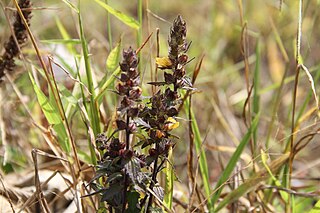
Alectra is a genus of flowering plants in the family Orobanchaceae. It comprises hemiparasitic species which occur in tropical and southern Africa, including Madagascar, and tropical and subtropical Asia.

Faurea rochetiana, also known as the broad-leaved beechwood, is a tree found in much of Africa from Sudan south to Limpopo, Mpumalanga and northern KwaZulu-Natal. The tree is small and leafy. It has wider leaves, larger flowers and flower veins and also denser hairy twigs than the bushveld beechwood. The tree's national number is 76.














